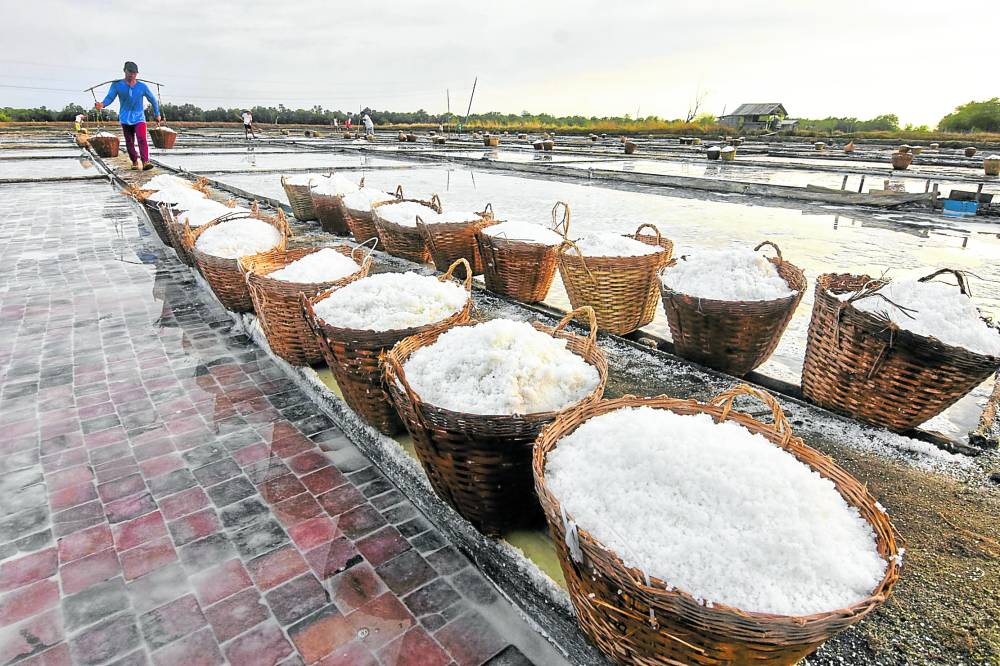Pangasinan salt farmers brood over lack of buyers

WHERE’S THE ‘BUY LOCAL’ MOVEMENT? The import glut is hurting this local salt farmer and scores of others at Barangay Amalbalan in Dasol, Pangasinan. —WILLIE LOMIBAO
DASOL, Pangasinan, Philippines — The lack of buyers has been troubling salt makers in this town for months, a challenge that persists despite renewed government efforts to revitalize the industry.
Ironically, the market drought is increasingly taking its toll on the supposed beneficiaries of the recently enacted Republic Act No. 11985, or the Philippine Salt Industry Development Act.
Signed by President Marcos on March 11, the law aims to increase local salt production to attain self-sufficiency, make it more attractive as a source of livelihood, devote more areas to the industry, and ultimately turn the country into a net exporter of salt.
In an interview on May 22, Dasol Municipal Agriculturist Frieda Makinano said the dearth of buyers began to be felt in February, just when production was peaking.
The prolonged hot season actually led to a bumper harvest, but great expectations over the impressive volume eventually turned sour.
Article continues after this advertisementEven the salt farm operated by the Pangasinan provincial government in Bolinao town could not find a market for the 5,000 metric tons that have piled up in its warehouse, according to Nestor Batalla, the assistant provincial agriculture officer in charge of the 473-hectare salt farm.
Article continues after this advertisement“It’s not only the Dasol salt farmers who have no market; even those from Bolinao and Anda have unsold stocks,” Batalla told the Inquirer on Wednesday.
Heavy reliance on imports
Batalla expressed hope that the new law, which also imposes a 9-percent tariff on imported salt, would help reduce inflow from foreign sources once it is fully implemented.
The law is still awaiting its implementing rules and regulations, or IRR, he noted.
Records from the Philippine Statistics Authority and the Bureau of Fisheries and Aquatic Resources show that the country imports 550,000 MT of salt annually, which translates to about 92 percent to 93 percent of the country’s requirements. Dasol alone produces 300 MT of salt annually.
Another set of data from the Philippine Chamber of Agriculture and Food Inc. shows that the country sources 93 percent of its salt requirement from Australia and China, up from only 15 percent in 1990.
A 2024 study published by the Philippine Journal of Fisheries noted that, despite being archipelagic, the Philippines heavily relies on salt imports.
The country produces about 114,623.29 MT, or 16.78 percent of the country’s salt requirements of 683,000 metric tons, with Occidental Mindoro being the biggest salt-producing province with a share of 57.43 percent, it added.
Supposedly a ‘boon’
Edwin Tolete, president of the Dasol Salt Makers Association, said the “long, blistering sunny season is a boon to the industry” as a “baingan” (a salt bed typically measuring 18 feet by 20 feet) could produce three to five “kaing” (baskets) of rock salt.“On days when it is not that hot, a baingan could produce only one kaing. But now, when we should be earning more, we seem to have lost our market,” Tolete said.
The association has around 200 members, of whom 50 own salt farms. However, only half of the farm owners have “bodegas” or warehouses.
According to Tolete, the bodegas are currently filled to capacity, leaving no choice for the farmers but to keep the rest of their salt harvest in the farms piled up in sacks.
Makinano said some producers had been forced to transport their salt to Alaminos City or wherever warehouse space was still available.
And the onset of the wet season brings a new set of worries: salt kept merely in makeshift bodegas, tents or sheds could just melt away under a leaky roof.
Down to P100 per sack
Her own family, Makinano said, still has an unsold stock amounting to 2,000 sacks (75 kilograms each) or 140 tons of salt. “We don’t know yet what to do about it.’’
Tolete, the association president, still has to find a bulk buyer for his 200 unsold sacks of salt. “Many of us have no other source of income, so where would we get the money to buy essentials like food?” he asked.
Last year, a 75-kilo sack of salt sold for P500. Nowadays, many producers are forced to sell a sack for P200 or less, just to have cash for their daily household needs.
On Thursday, someone among the association members sold a sack of salt for only P100.“We tried to convince our members not to sell below P350 per sack. But they have no other choice. Still, almost no one is buying,” Tolete said.
Only two trucks sent by bulk buyers came to town earlier this week. Around this time last year, an average of 20 trucks arrived daily.
Contract bid
Dasol’s salt producers still have one source of hope in the near future: they intend to bid for a contract to supply the Philippine Coconut Authority (Philcoa), which pushes the use of salt as fertilizer for coconut trees.
But Tolete explained that to qualify as a bidder, his association must first be converted into a cooperative.
“We are running out of time. Our salt would already have melted before we could be accredited as a cooperative,” he said.
For a longer, more sustainable lifeline, Makinano called on the government to not only prioritize boosting local salt production but also link the farmers to a wider network of buyers who would patronize the Filipino “asin.”
“We also hope (for other forms of) assistance during the off-season when salt production is not possible, and more training to enhance production,” she said. —With a report from Inquirer Research
Sources: Inquirer Archives, nfrdi.da.gov.ph